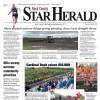
Last week I gave you all the rundown about how the 2021 pheasant season went.
Record-keeping for some outdoor people is totally off the charts. One guy I know records every flush and every harvested bird on every spot he has ever hunted over the past 20 years before he goes to bed. I would fall asleep trying to do that.
I don’t have a lot of my outdoor facts and figures written down. Mostly they live in my memory back in my favorite brain folder called a life outdoors. One of the events that my memory is really good about is if one of my dogs gets hurt or injured. These things I always remember.
The more dogs you own, the more likely you are to have dog injuries. This is no different than them vomiting on the rug. If you have one dog, this is a rare occurrence; if you have four dogs, it happens four times more often.
This season I had three dog injuries. Tracer, my 10-year-old, was racing all of the other dogs down the hall toward the garage I was headed to and collided with my 7-year-old, Sarge. Sarge is the linebacker and Tracer is the quarterback, and the end result was a front right leg limp on Tracer that sidelined him for two weeks. Meds were acquired and the injury did linger on and off for almost the first half of the season. Tracer would later tangle with barbed wire and that was eight stitches and another two weeks on injured reserve.
My newest dog, the one that needed the experience more than the rest of my seasoned team, was Ghost. He was 1 1/2 years old at the start of the season.
I describe a newly trained dog as being the equivalent of a vocational school graduate in the area of diesel mechanics. When students graduate from a diesel program, they have acquired a tool box full of tools and the knowledge to use each tool for its intended use. All that they lack is experience. An inexperienced mechanic cannot compete against a mechanic that has been twisting wrenches for 20 years.
The same expectations have to be used with a new dog. Take that inexperienced dog hunting a lot. Do so with no other dogs or hunters other than yourself if you can. This is where the most beneficial experiences come from.
There were fewer birds this season so it’s hard to leave the A-Team mechanics home to take out the new vocational school graduate, but this is what I did. This is another reason my total bird harvest was down this year. Ghost was doing really well. As is normal with young dogs, he was a little high strung and hunted really fast. With time he will slow down and start to use his sniffer more efficiently.
We were walking up a small creek and smashed his front left leg into a sharp steel edge of a field tile outlet. When the outlet was cut to the proper length, the saw line did not line up, and it left what looked like the head of a spear bent down. Ghost caught that pointed edge, and it tore a seam about three inches long, deep enough to affect the tendons in his leg.
Off to the vet we went. After cleaning out the wound, the vet moved Ghost’s toes and I could see the tendons move in his leg. No tendon was severed, but they were traumatized and a fair amount of swelling was present. This was a pretty extensive injury and should have mended quite quickly. By now you have to add in the “luck of the Scoot.” My nickname is Scoot, and if anything can go bad, it usually goes bad for me.
Ghost started building up fluid in that spot and had to have it drained. The stitches under the skin started an irritation, and what would have been a two-week period on the injured reserve list ended up being about five weeks before he was ready to go hunting again.
He made it out the last two weeks of the season, and by then all of the roosters were super smart. December was a really difficult month for me as far as flushing and killing any birds. Ghost really spent most of this season with me trying to keep him controlled and not ramming around.
He missed the best part of his first year not getting the experience he needed. You can say, “Well, there is always next year,” and I said that, too. But a hunting career for a Labrador is about 10 years long, and 10 percent of that time was kind of a washout.
All of the dogs are back to their pre-season fitness levels but will now have to wait another nine months to get back to doing what they love and were bred to do. Many dogs make you know your veterinary really well, and I visited my support staff for a holiday get-together after the season closed. It is important to have a relationship with a vet you trust and I get lots of opportunities to do just that.
Here’s to hoping the season of 2022 does not include frequent trips to see them. Only time will tell, but a life without four dogs seems to me to be a life not lived to its fullest. Only if you hunt with a dog or dogs can you relate to my issues, but there is not one serious hunter I know who would ever trade for a day without them.
Scott Rall, Worthington, is a habitat conservationist, avid hunting and fishing enthusiast and is president of Nobles County Pheasants Forever. He can be reached at scottarall@gmail.com. or on Twitter @habitat champion.



